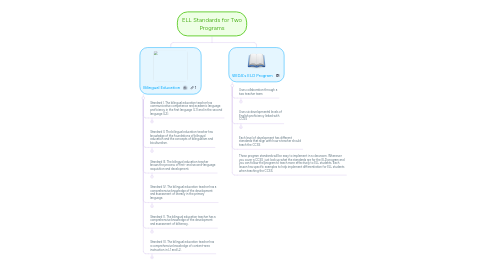
1. Bilingual Education
1.1. Standard I. The bilingual education teacher has communicative competence and academic language proficiency in the first language (L1) and in the second language (L2).
1.1.1. What Teachers Can Do: prepare lessons, materials, and assessments in L1 and L2, use academic language competently in L1 and L2 to deliver instruction, and communicate effectively (orally and in writing) with families, colleagues, and the community in L1 and L2.
1.2. Standard II. The bilingual education teacher has knowledge of the foundations of bilingual education and the concepts of bilingualism and biculturalism.
1.2.1. What Teachers Can Do: use knowledge of the historical, legal, legislative, and global contexts of bilingual education to be an effective advocate for the bilingual education program and for bilingual learners and address the affective, linguistic, and cognitive needs of bilingual learners
1.3. Standard III. The bilingual education teacher knows the process of first- and second-language acquisition and development.
1.3.1. What Teachers Can Do: apply linguistic concepts to support learners’ language and literacy development in L1 and L2 and assist learners in making connections between languages (e.g., noting similarities and differences, using cognates)
1.4. Standard IV. The bilingual education teacher has a comprehensive knowledge of the development and assessment of literacy in the primary language.
1.4.1. What Teachers Can Do: use a variety of literacy assessments to plan and implement literacy instruction in the primary language
1.5. Standard V. The bilingual education teacher has a comprehensive knowledge of the development and assessment of biliteracy.
1.5.1. What Teachers Can Do: use oral language techniques and explicit instruction in phonemic awareness and decoding to promote literacy in L2 and assess and monitor learners’ level of proficiency in oral and written language and reading in L1 and L2 to plan appropriate literacy instruction.
1.6. Standard VI. The bilingual education teacher has a comprehensive knowledge of content-area instruction in L1 and L2.
1.6.1. What Teachers Can Do: integrate language arts skills in L1 and L2 into all content areas and use content-area instruction to promote learners’ language acquisition and development in L1 and L2
2. WIDA's ELD Program
2.1. Uses collaboration through a two teacher team
2.1.1. The classroom teacher focuses on content knowledge while the ELL teacher focuses on language mastery
2.2. Uses six developmental levels of English proficiency linked with CCSS
2.2.1. The six levels of English proficiency are entering, emerging, developing, expanding, bridging, and reaching.
